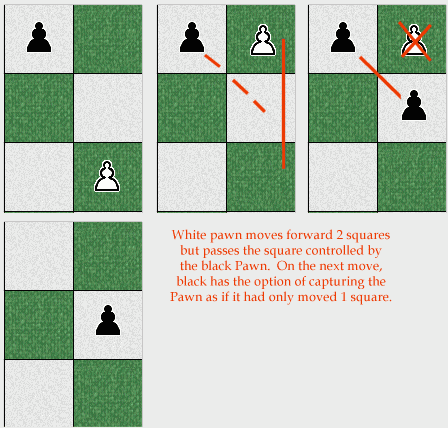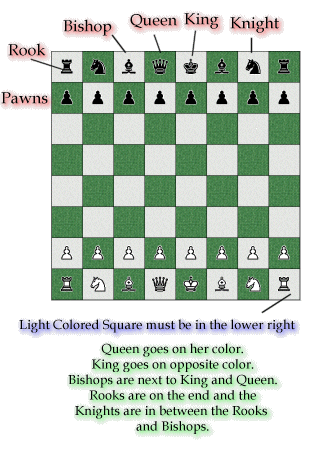Click here for The Reluctant Messenger (Host Site)
The Reluctant Messenger's Chess Center For Beginners









Chess is one of the few games where neither luck nor physical strength are an advantage. This game is mind vs mind. The rules are simple but the game can take a lifetime to master. Perhaps that is its main attraction, you don't get bored.This section only covers the very basics. The minimum needed to push pieces around and not break the rules. For the official international rules see: F.I.D.E Chess Rules.
The game is played on 64 squares of light and dark. The game is oriented so that both players have a light square at their lower right hand.
Board Setup
This is the official way a chess board should be set up. The pieces are: King, Queen, Bishops, Knights, Rooks and Pawns. The board must be set up so that the lower right square is the light colored square. The Queen goes on the back rank, in the middle square that is the same color she is. The King goes on an opposite colored square. The Bishops are on either side of the King and Queen. The Rooks go on the back rank in the corners and the Knights go in between the Rooks and the Bishops.The objective of the game is to checkmate the opponents King. The definition of a checkmate is a King under attack by one or more of the opponents pieces and capture is unavoidable. If the King under attack is unable to be saved by either, moving, capturing the attacking piece, or blocking the attacker with another piece, the King is considered as checkmated. The game ends before the King is ever actually "captured."
The pieces move as follows:
King: Moves one square in any direction. (up, down, left, right and or diagonal). The King can never move into danger. If the King is in danger, dealing with the danger is not opptional. If you King is in check (threatened to be captured), you must move, capture or block the attack. No other move is legal while a King is under attack. Rooks: one or more squares in either the up down direction or left right direction. Bishops: Moves diagonal and always stays on the same colored square. Queen: Can move like a Rook or a Bishop.
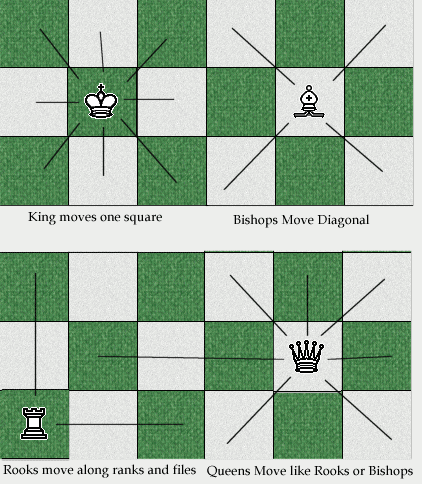
Knights: Moves within a 6 square rectangle and always ends up on a different colored square. Always described as moving in an L shape within a 6 square rectangle.
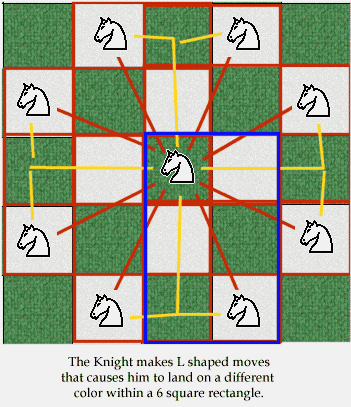
Pawns: Move only forward. Can move two squares forward their first move. Otherwise, they always move forward one square or capture diagonaly one square.
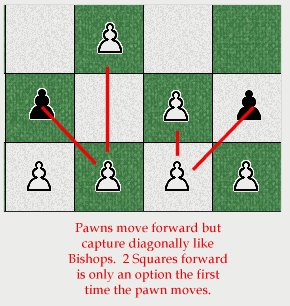
Castling: Under certan circumstances the King can move more than one square in conjunction with a Rook move. This is a one time move that can only occur under certain circumstances. 1) Neither the Rook or King has moved. 2)The squares between the King and Rook are empty. 3)The King is not under check. (Threatened to be captured). 4)None of the squares the King will move over are under attack nor is the square the King will land on. The moves is considered a King move and is executed Kingside by moving the King two squares to the right and jumping the Rook over the King to land in the square adjacent to the King's left. It is executed Queenside by moving the King two squares to the left and jumping the Rook over the King to land in the square adjacent to the King on its right.
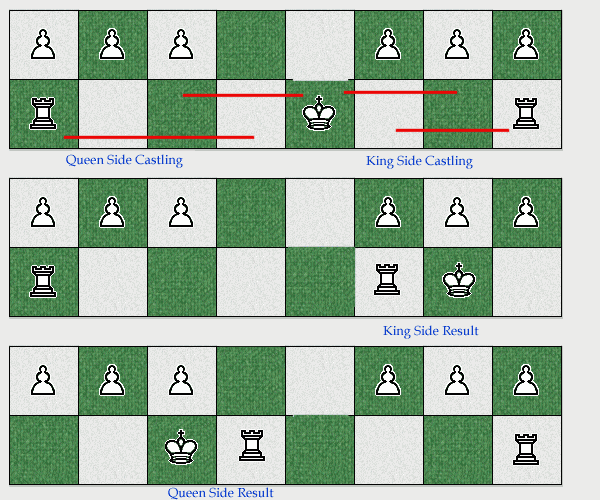
En Passant: This pawn move rule was added when the pawns were allowed to move 2 squares on their first move. If this two square moves causes the pawn to jump pass a square under attack by an opponents pawn, the opponent has a one time option on the next move to capture the pawn as if it has moved only one square forward. If the opponent declines to execute the capture on the next move, the pawn can no longer be capture "En passant." Note: En Passant is French for "It Passed or In Passing."
